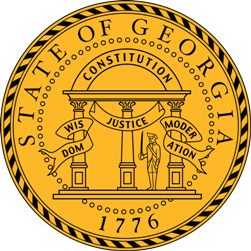Blue Pairings with the Peach State
A brief look at the last time all-Democratic U.S. Senate delegations simultaneously represented Georgia and other states

Once Jon Ossoff and Raphael Warnock are seated following the Georgia Secretary of State’s certification of last Tuesday’s runoff U.S. Senate elections, the Peach State will have two Democrats in the chamber for the first time in 18 years.
Max Cleland and Zell Miller were the last pair of Democrats to serve from the state which ended on January 3, 2003 following Saxby Chambliss’ defeat of Cleland in the 2002 general election.
Georgia will now send two Democrats to the U.S. Senate at the same time as a handful of other states for the first time in a few generations.
For example, the last time Georgia and Arizona were each represented by Democrats was 68 years ago on January 3, 1953 when Carl Hayden and the recently defeated Ernest McFarland were in office in Arizona alongside Walter George and Richard Russell.
It was 54 years ago (January 1967) when all-Democratic delegations last served both Oregon (Wayne Morse, Maurine Neuberger) and Georgia (Richard Russell, Herman Talmadge).
Five states last sent two Democrats to the U.S. Senate alongside Georgia during the 1970s:
- Virginia (Harry Byrd, Jr. and William Spong) in January 1971 (with Russell and Talmadge)
- New Mexico (Clinton Anderson and Joseph Montoya) in January 1973 (with Talmadge and Sam Nunn)
- Rhode Island (John Pastore and Claiborne Pell) in December 1976 (with Talmadge and Nunn)
- Colorado (Floyd Haskell and Gary Hart) in January 1979 (with Talmadge and Nunn)
- New Hampshire (Thomas McIntyre and John Durkin) in January 1979 (with Talmadge and Nunn)
Illinois (Alan Dixon, Paul Simon) and Nevada (Harry Reid, Richard Bryan) last had all-Democratic delegations in the chamber at the same time as Georgia in January 1993 when Nunn and Wyche Fowler represented the Peach State.
Eleven states who have two Democrats in the senate in the 117th Congress today also had two Democrats during the 107th Congress when Georgia last sent two Democrats to D.C.: California, Connecticut, Delaware, Hawaii, Maryland, Massachusetts, Michigan, Minnesota, New Jersey, New York, and Washington.
The states with the longest gap between being represented by two Democrats in the U.S. Senate at the same time as Georgia are Pennsylvania (January 1947), Utah (January 1947), and Idaho (October 1949).
That excludes the two states which have never sent all-Democratic delegations to the U.S. Senate: Kansas and Vermont.
Follow Smart Politics on Twitter.

As a practical matter, the Peach State last had a D US senate tandem in early 01 of 1993; onetime liberal (by GA standards) Zell Miller not only endorsed Bush “43” for re-election in 2004 (4 years before “indie DEM” J I Lieberman did likewise), but also had not bothered to attend caucus meetings, ignored even his state party affairs, and had been by all accounts an independent disguised as a Democrat during his 4+ – year tenure.
I gather Warnock will be the “senior” senator, even presuming they take their seats on the same day – or perhaps this would mark one of the very few occasions where both have equal seniority?
There seems to be some disagreement on the Ossoff-Warnock seniority matter, at least if Wikipedia is your main source on these sorts of things. For a long while, Wikipedia claimed that the tiebreaker procedure for seniority in the Senate is to go alphabetically by surname, as is done in the House; but now it lists the “new-state” tiebreaker criterion, wherein if two senators are sworn in on the same day with the same résumé, then the senior senator is the one with the longer term. However, either method would give Ossoff greater seniority than Warnock. I can’t find a source that addresses this matter specifically, yet. Perhaps a news article will mention it when they are sworn in.
This was my recollection/assumption – that the full-term US Senator gets the seniority if sworn in on the same day. But I can’t point to any documentation stating this.
A report by the House parliamentarian from 2007 suggests that the senator with the longer term is the senior senator, though an Ossoff spokesperson, as well as the chair of the Georgia Democratic Party, have asserted that Ossoff is senior by alphabetical order. [Warnock posted a tweet on January 19 making fun of this issue.] Someone on the Wikipedia talk page found the example of Sens. Charles O. Andrews and Claude Pepper, Democrats of Florida who won special elections in 1936 and were thus sworn in on the same day; Andrews had the longer term, and also precedes Pepper alphabetically.
As a practical matter, the Peach State last had a D US senate tandem in early 01 of 1993; onetime liberal (by GA standards) Zell Miller not only endorsed Bush “43” for re-election in 2004 (4 years before “indie DEM” J I Lieberman did likewise), but also had not bothered to attend caucus meetings, ignored even his state party affairs, and had been by all accounts an independent disguised as a Democrat during his 4+ – year tenure.
I gather Warnock will be the “senior” senator, even presuming they take their seats on the same day – or perhaps this would mark one of the very few occasions where both have equal seniority?